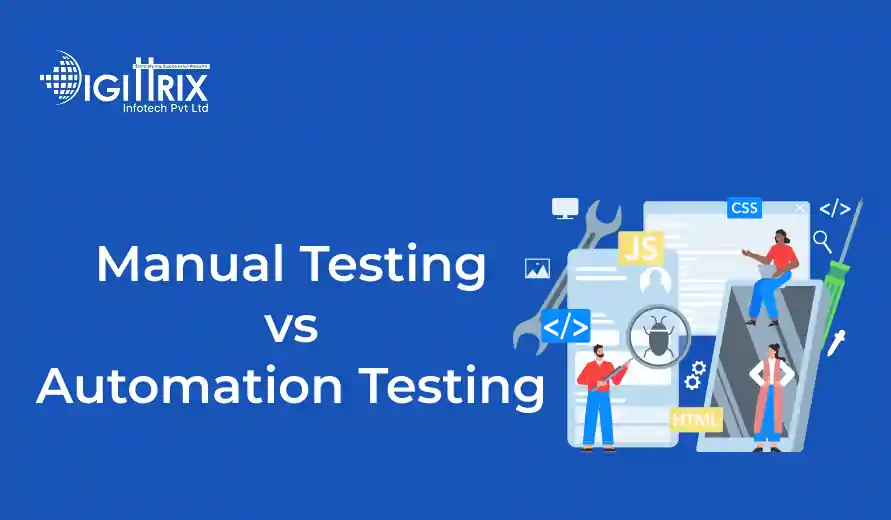Manual vs Automation Testing highlights speed, accuracy, and cost balance. Manual testing offers flexibility, while automation ensures fast execution, reusable scripts, and reduced long-term expenses.
Highlights
With Over 14 years of Experience in the IT Field, Helping Companies Optimise there Products for more Conversions

Software testing is a vital part of the development life cycle. It determines whether the final product is ready for users or still needs improvements. Over the years, testing teams have employed two main methods—manual testing and automation testing. Each approach has its own advantages, challenges, and best-suited scenarios. Knowing when to use manual testing and when to switch to automation can save time, reduce costs, and improve the product's quality.
This article discusses manual testing, automation testing, their pros and cons, and how businesses can apply both in different situations. This detailed comparison offers a clear understanding of which testing method is best suited for various projects, whether it involves custom software, mobile apps, or websites.
Testing an app? Read Digittrix’s guide to mobile app testing to catch issues before launch!
Manual testing involves assessing software applications without the use of automated tools. Testers physically execute test cases, verify functionality, and find bugs by following written or exploratory test plans. For example, when testing a mobile app, a tester might manually check login, registration, payments, and navigation by interacting with the app as a typical user.
Automation testing employs specialized tools and scripts to run test cases automatically, eliminating the need for human input. Once test scripts are developed, they can be reused across different builds and projects. For instance, in a web app, automation testing can efficiently run thousands of login attempts, form submissions, or payment transactions without manual intervention.
Manual testing is slower because testers need to execute each test case step by step. Automation testing is faster after scripts are created. In large projects like custom software development, where multiple features are tested repeatedly, automation saves a lot of time.
Manual testing may seem cheaper at first because it doesn't need tools or scripting. However, in long-term projects like mobile app or website development services, manual testing becomes more expensive due to repetitive efforts. Automation requires higher initial costs but is more cost-effective for projects that need regular updates and regression testing.
Manual testing relies on human involvement and can lead to errors if testers lose focus. Automation testing provides accurate results for repetitive tasks. However, it is important to recognize that human judgment remains valuable when usability, appearance, and user experience matter.
The best results often come from combining manual and automated testing. Businesses should not rely on only one approach. For example:
This combination yields faster results without compromising human creativity and judgment.
In mobile app development, manual testing is initially used to assess the app’s appearance and user flow. Later, automation testing is applied to verify login, signup, push notifications, and payment features across multiple devices and operating systems.
For website development services, manual testing ensures design consistency and usability across browsers. Automation testing is then employed to validate large volumes of form submissions, database connections, and security checks.
Choosing the right testing method directly influences business results. A well-tested application gains user trust and lowers the chance of failure after launch. A software development company that effectively uses both manual and automation testing can provide higher-quality solutions.
For example, in mobile app development, faster testing decreases the time to market, helping businesses launch products more quickly. In custom software development, combining different testing methods guarantees the product works correctly for complex tasks. The testing strategy not only enhances the product but also creates long-term value for businesses working with a software development company.
As businesses move to digital platforms, the need for faster, error-free testing will only increase. While manual testing still plays a key role in human judgment and usability, automation testing will keep growing because of its speed and accuracy.
Projects like on-demand app development are seeing increased demand for automation due to ongoing updates. Similarly, website development services now rely heavily on automation for performance and security assessments. However, combining manual effort with automation remains the most effective way to deliver high-quality software solutions.
Curious about automation? Learn how IT automation benefits businesses and individuals with Digittrix’s practical guide!
Manual and automation testing are both essential in the software development life cycle. Manual testing provides human judgment and flexibility, while automation testing offers speed and accuracy for repetitive tasks. Companies should select methods based on project size, complexity, and long-term objectives.
Whether it's custom software, a mobile app, or website development, using both approaches yields the most dependable results. A software development company that employs both manual and automated testing can produce products that are effective and easy to use.
By applying proper testing methods at each stage, businesses can save time, reduce expenses, and maintain high software quality.
In today’s competitive software market, choosing the right testing approach is essential for delivering defect-free applications. Both manual and automation testing are vital in achieving faster results and dependable performance. While manual testing helps identify usability and functionality issues, automation testing saves time by handling repetitive and large-scale checks.
At Digittrix, we provide comprehensive testing solutions that combine manual and automated methods for various projects. Whether you're creating a mobile app, an on-demand platform, or a custom enterprise system, our QA team ensures your product undergoes thorough testing for performance, security, and compatibility.
Looking to improve the quality and dependability of your application with the right testing approach? Schedule a consultation with our experts today by calling +91 8727000867 or emailing digittrix@gmail.com.

Do you need help in ?




Join over 1500+ businesses we've already helped!
Manual testing is performed by human testers, whereas automation testing uses tools and scripts to run test cases automatically.
Automation testing is faster because scripts can be reused and executed quickly, unlike manual testing, which requires step-by-step execution.
Yes, combining both methods gives better results. Manual testing works well for usability, while automation is better for repeated and large-scale testing.
It has higher initial costs due to tool setup and scripting, but it becomes cost-effective in long-term or large projects.

©2026Digittrix Infotech Private Limited , All rights reserved.